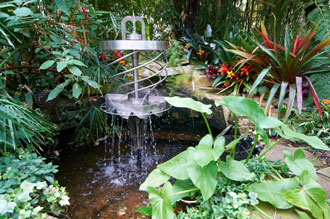Tokina AF 11-16mm f/2.8 AT-X 116 PRO DX
Tokina AF 11-16mm f/2.8 AT-X 116 PRO DX: Performance
As far as sharpness is concerned, this lens performs best at 11mm at maximum aperture. At f/2.8 the sharpness in the centre of the image is already outstanding, and the clarity towards the edges of the frame is good. At 11mm stopping down reduces centre sharpness, but improves sharpness towards the edges gradually and the best quality from corner to corner is achieved at f/8.Zooming to 13mm results in a reduction of clarity across the frame, especially at brighter apertures. At f/2.8 sharpness in the centre is fairly good, and only fair towards the edges. Just as at 11mm, peak quality across the frame is achieved at f/8, where sharpness in the centre is outstanding, and very good towards the edges.
Finally, at 16mm, sharpness in the centre returns to good levels at f/2.8 although the quality towards the edges remains fair. Stopping down doesn't have as great an effect on the clarity towards the edges of the frame at this focal length, with sharpness here only reaching good levels by f/8.
| Resolution at 11mm | Resolution at 13mm | |
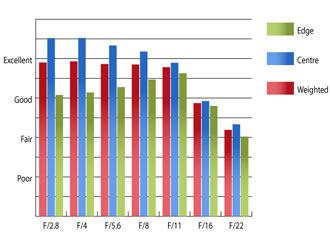 | 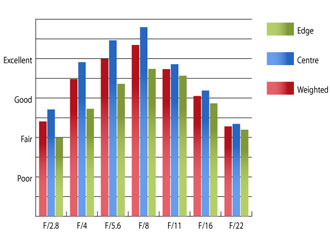 | |
| Resolution at 16mm | How to read our graphsThe blue column represents readings from the centre of the picture frame at the various apertures and the green is from the edges. Averaging them out gives the red weighted column.The scale on the left side is an indication of actual image resolution. The taller the column, the better the lens performance. Simple. For this review, the lens was tested on an Nikon D300 using Imatest. | |
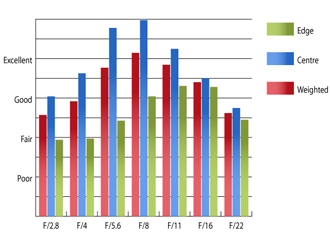 |
Levels of chromatic aberrations towards the edges of the frame are high throughout the zoom range, exceeding two pixel widths at each zoom setting and aperture. This level may cause issues with any high contrast subjects towards the edges of the frame, such as tree branches and will show in large reproductions of images.
| Chromatic Aberrations at 11mm | Chromatic Aberrations at 13mm | |
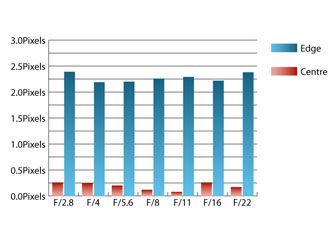 | 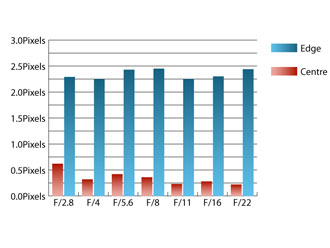 | |
| Chromatic Aberrations at 16mm | How to read our chartsChromatic aberration is the lens' inability to focus on the sensor or film all colours of visible light at the same point. Severe chromatic aberration gives a noticeable fringing or a halo effect around sharp edges within the picture. It can be cured in software.Apochromatic lenses have special lens elements (aspheric, extra-low dispersion etc) to minimize the problem, hence they usually cost more. For this review, the lens was tested on an Nikon D300 using Imatest. | |
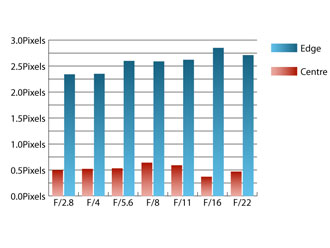 |
For such a wide lens, with a bright maximum aperture, falloff of illumination towards the corners is remarkably well controlled. At 11mm the corners are only 0.9 stops darker than the centre, and at 16mm this level drops to 0.4 stops. Visually uniform illumination is achieved at f/4 throughout the zoom range.
As you might expect distortion is quite prominent at 11mm, but 6.15% barrelling isn't overly strong for a lens this wide. At 16mm the barrel distortion gives way to mild pincushion distortion. Here Imatest detected 0.5% pincushion, which shouldn't pose issues for most images. At both ends of the zoom range, the distortion pattern is uniform across the frame, so it should be easy to correct in image editing software afterwards.
A deep, flock-lined petal-shaped hood is supplied with the lens, which does an excellent job of keeping extraneous light that may cause flare off the front element. Strong point sources of light, such as the sun can cause flare and loss of contrast when towards the edges of the frame, or just out of the imaging area, but only under severe circumstances.
Add your message
Login required
Please login here or if you've not registered, you can register here. Registering is safe, quick and free.
Please login here or if you've not registered, you can register here. Registering is safe, quick and free.
photodo Stats
1102 lenses
428 MTF tests
74 in-depth photodo reviews
100+ users join each day
Help the lens community by reviewing or rating a lens today via our lens search
428 MTF tests
74 in-depth photodo reviews
100+ users join each day
Help the lens community by reviewing or rating a lens today via our lens search
Latest Lens Reviews
- Chinon 28mm f/2.8 Vintage Lens Review
- Canon EF 70-200mm f/4L IS II USM Lens Review
- Samyang AF 85mm f/1.4 EF Review
- Sigma 70mm f/2.8 DG Macro Art Review
- Samyang AF 24mm f/2.8 FE Review
- Meike 50mm f/1.7 Review
- Tamron 70-210mm f/4 Di VC USD Review
- Lensbaby Burnside 35mm f/2.8 Review
- Asahi Super Takumar 50mm f/1.4 Review
- Asahi Super-Multi-Coated Takumar 135mm f/3.5 Review




